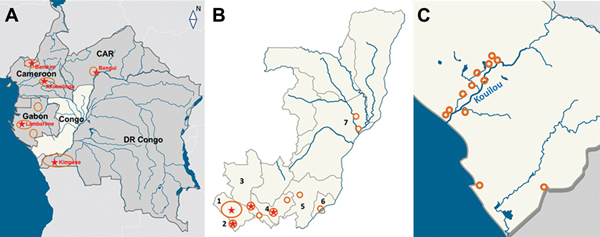Volume 20, Number 6—June 2014
Letter
Buruli Ulcer Disease in Republic of the Congo
Figure

Figure. Buruli ulcer–endemic areas in the Republic of the Congo (RC) and neighboring countriesA) Buruli ulcer cases have been reported in all countries neighboring RCCAR, Central African Republic; DR Congo, Democratic Republic of the CongoB) RC (representing the white area in panel A)The numbers indicate the 7 departments or communes (of 12 total) where PCR-positive cases of Buruli ulcer disease were diagnosed1, Kouilou Department; 2 Pointe Noire Commune; 3, Niari Department; 4, Bouenza Department; 5, Pool Department; 6, Brazzaville Commune; 7, Cuvette DepartmentC) Kouilou Department (department 1 in panel B)Most Buruli ulcer case-patients from Kouilou Department were living close to the Kouilou RiverStars indicate locations of health centers that treat Buruli ulcer disease; circles indicate areas where persons with Buruli ulcer disease were identified.